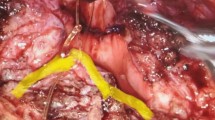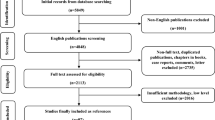Abstract
This study aimed at investigating the efficacy and safety of retrograde intrarenal surgery (RIRS) in treatment of renal pelvic stone larger than 2 cm against the percutaneous nephrolithotomy (PCNL). Between March 2018 and December 2020, 121 patients were randomized to undergo PCNL (60 patients), or RIRS (61 patients). Both groups were compared in terms of operative time, intraoperative complications. Postoperative complications were assessed based on Clavien–Dindo grading system. Stone-free rates were evaluated by CT scan 6 weeks after surgery. No significant difference were observed between both groups in perioperative criteria. The main operative time was slightly longer in PCNL group (105 vs 95 min, p = 0.49). Stone clearance was higher in PCNL, yet the difference was not significant. (53 patients in PCNL group had either complete clearance or residual fragments < 4 mm, compared to 49 in RIRS group (p = 0.22). Blood transfusion rate was 8.3% in PCNL compared to 1.6% in RIRS group, with a trend towards significance (p = 0.08). Post-operative fever was higher in RIRS, yet it fell just short of statistical significance (13.1% vs 5.0%, p = 0.12). Compared to PCNL, RIRS displayed acceptable efficacy with less risk of bleeding requiring transfusion. It can be applied to patients with large renal pelvic stone as an alternative to PCNL.
Similar content being viewed by others
References
Trinchieri A (2008) Epidemiology of urolithiasis: an update. Clin Cases Miner Bone Metab: Off J Ital Soc Osteoporos, Miner Metab, Skelet Dis 5(2):101–106
Junbo L, Yugen L, Guo J, Jing H, Ruichao Y, Tao W (2019) Retrograde intrarenal surgery vs. percutaneous nephrolithotomy vs. extracorporeal shock wave lithotripsy for lower pole renal stones 10–20 mm: a meta-analysis and systematic review. Urol J 16(2):97–106. https://doi.org/10.22037/uj.v0i0.4681
Türk C, Petřík A, Sarica K, Seitz C, Skolarikos A, Straub M, Knoll T (2016) EAU guidelines on interventional treatment for urolithiasis. Eur Urol 69(3):475–482. https://doi.org/10.1016/j.eururo.2015.07.041
Geraghty R, Abourmarzouk O, Rai B, Biyani CS, Rukin NJ, Somani BK (2015) Evidence for ureterorenoscopy and laser fragmentation (URSL) for large renal stones in the modern era. Curr Urol Rep 16(8):54. https://doi.org/10.1007/s11934-015-0529-3
Geraghty RM, Ishii H, Somani BK (2016) Outcomes of flexible ureteroscopy and laser fragmentation for treatment of large renal stones with and without the use of ureteral access sheaths: results from a university hospital with a review of literature. Scand J Urol 50(3):216–219. https://doi.org/10.3109/21681805.2015.1121407
Clavien PA, Barkun J, de Oliveira ML, Vauthey JN, Dindo D, Schulick RD, de Santibañes E, Pekolj J, Slankamenac K, Bassi C, Graf R, Vonlanthen R, Padbury R, Cameron JL, Makuuchi M (2009) The Clavien-Dindo classification of surgical complications: five-year experience. Ann Surg 250(2):187–196. https://doi.org/10.1097/SLA.0b013e3181b13ca2
de la Rosette J, Assimos D, Desai M, Gutierrez J, Lingeman J, Scarpa R, Tefekli A, CROES PCNL Study Group (2011) The clinical research office of the endourological society percutaneous nephrolithotomy global study: indications, complications, and outcomes in 5803 patients. J Endourol 25(1):11–17. https://doi.org/10.1089/end.2010.0424
Kim HY, Choe HS, Lee DS, Yoo JM, Lee SJ (2020) Is absence of hydronephrosis a risk factor for bleeding in conventional percutaneous nephrolithotomy. Urol Jl 17(1):8–13. https://doi.org/10.22037/uj.v0i0.4826
Wu P, Wang L, Wang K (2011) Supine versus prone position in percutaneous nephrolithotomy for kidney calculi: a meta-analysis. Int Urol Nephrol 43(1):67–77. https://doi.org/10.1007/s11255-010-9801-0
Sanguedolce F, Bozzini G, Chew B, Kallidonis P, de la Rosette J (2017) The evolving role of retrograde intrarenal surgery in the treatment of urolithiasis. Eur Urol Focus 3(1):46–55. https://doi.org/10.1016/j.euf.2017.04.007
Ermis O, Somani B, Reeves T, Guven S, Pes PL, Chawla A, Hegde P, de la Rosette J (2020) Definition, treatment and outcome of residual fragments in staghorn stones. Asian J Urol 7(2):116–121. https://doi.org/10.1016/j.ajur.2019.12.013
Göger YE, Özkent MS, Kılınç MT, Taşkapu HH, Göger E, Aydın A, Sönmez MG, Karalezli G (2021) Efficiency of retrograde intrarenal surgery in lower pole stones: disposable flexible ureterorenoscope or reusable flexible ureterorenoscope? World J Urol 39(9):3643–3650. https://doi.org/10.1007/s00345-021-03656-y
Bozzini G, Filippi B, Alriyalat S, Calori A, Besana U, Mueller A, Pushkar D, Romero-Otero J, Pastore A, Sighinolfi MC, Micali S, Buizza C, Rocco B (2021) Disposable versus reusable ureteroscopes: a prospective multicenter randomized comparison. Res Rep Urol 13:63–71. https://doi.org/10.2147/RRU.S277049
Palmero JL, Durán-Rivera AJ, Miralles J, Pastor JC, Benedicto A (2016) Comparative study for the efficacy and safety of percutaneous nephrolithotomy (PCNL) and retrograde intrarenal surgery (RIRS) for the treatment of 2–3,5 cm kidney stones. Estudio comparativo de eficacia y seguridad de la nefrolitotomía percutánea (NLPC) y la cirugía retrógrada intrarrenal (CRIR) para litiasis renales de 2–3,5 cm. Archivos espanoles de urologia 69(2): 67–72.
Karakoç O, Karakeçi A, Ozan T, Fırdolaş F, Tektaş C, Özkarataş ŞE, Orhan İ (2015) Comparison of retrograde intrarenal surgery and percutaneous nephrolithotomy for the treatment of renal stones greater than 2 cm. Turkish J Urol 41(2):73–77. https://doi.org/10.5152/tud.2015.97957
Karakoyunlu N, Goktug G, Şener NC, Zengin K, Nalbant I, Ozturk U, Ozok U, Imamoglu A (2015) A comparison of standard PCNL and staged retrograde FURS in pelvis stones over 2 cm in diameter: a prospective randomized study. Urolithiasis 43(3):283–287. https://doi.org/10.1007/s00240-015-0768-2
Bryniarski P, Paradysz A, Zyczkowski M, Kupilas A, Nowakowski K, Bogacki R (2012) A randomized controlled study to analyze the safety and efficacy of percutaneous nephrolithotripsy and retrograde intrarenal surgery in the management of renal stones more than 2 cm in diameter. J Endourol 26(1):52–57. https://doi.org/10.1089/end.2011.0235
Ali A, Mostafa H, Ismail A, Gamal M, Salah A, Roshdy M (2019) Retrograde intrarenal surgery versus mini-percutaneous nephrolithotripsy to treat renal stones 20 mm or larger in diameter using holmium: YAG laser. Egypt J Surg 38:766–771
Park J, Hong B, Park T, Park HK (2007) Effectiveness of noncontrast computed tomography in evaluation of residual stones after percutaneous nephrolithotomy. J Endourol 21(7):684–687. https://doi.org/10.1089/end.2006.0352
Yavuz G (2020).Comparison of RIRS and mini-PCNL for 2–3 cm renal lower calyx stones. Arch Urol. https://www.heraldopenaccess.us/openaccess/comparison-of-rirs-and-mini-pcnl-for-2-3-cm-renal-lower-calyx-stones
Jiang K, Zhang P, Xu B, Luo G, Hu J, Zhu J, Sun F (2020) Percutaneous nephrolithotomy vs. retrograde intrarenal surgery for renal stones larger than 2cm in patients with a solitary kidney: a systematic review and a meta-analysis. Urol J 17(5):442–448. https://doi.org/10.22037/uj.v16i7.5609
Polat S, Yarimoglu S, Koras O, Sahan M, Sefik E, Bozkurt IH, Degirmenci T (2021) Comparison of guy’s, S.T.O.N.E. and CROES scoring systems for predicting percutaneous nephrolithotomy outcomes in eldery patients. J Coll Physicians Surg–Pak: JCPSP 31(3):307–313. https://doi.org/10.29271/jcpsp.2021.03.307
Author information
Authors and Affiliations
Corresponding author
Ethics declarations
Conflict of interest
All authors have no conflict of interest.
Informed consent
Informed consent was given by all patients included in this study.
Additional information
Publisher's Note
Springer Nature remains neutral with regard to jurisdictional claims in published maps and institutional affiliations.
Rights and permissions
About this article
Cite this article
Fayad, M.K., Fahmy, O., Abulazayem, K.M. et al. Retrograde intrarenal surgery versus percutaneous nephrolithotomy for treatment of renal pelvic stone more than 2 centimeters: a prospective randomized controlled trial. Urolithiasis 50, 113–117 (2022). https://doi.org/10.1007/s00240-021-01289-9
Received:
Accepted:
Published:
Issue Date:
DOI: https://doi.org/10.1007/s00240-021-01289-9




